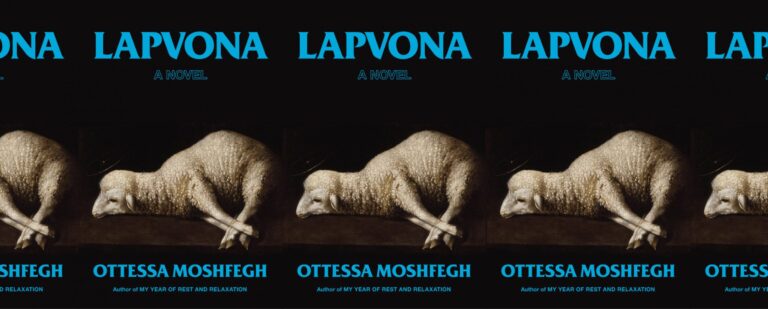The Limits of Social Media in No One Is Talking About This

“Why did the portal feel so private, when you only entered it when you needed to be everywhere?” asks the narrator of poet and memoirist Patricia Lockwood’s debut novel No One Is Talking About This, out today. “The portal,” an online space that feels akin to the Twittersphere, consumes the speaker—for the narrator and those like her, the portal becomes a place where they live, their phones tethering them online. As familiar as this consuming portal feels, so too does the political climate within the book: America is ruled by “the dictator,” a loathsome man whose petulant behavior never seems to result in his demise, and despite, or perhaps because, of his inflammatory nature, he has garnered radical supporters. “Every day we were seeing new evidence that suggested it was the portal that had allowed the dictator to rise to power,” the narrator observes.
No One Is Talking About This is unnervingly not hyperbolic in Lockwood’s lyric, humorous rendering of this familiar world. “At nine o’clock every night she gave up her mind,” the narrator states, suggesting that her use of the portal is contained to the evening. “Renounced it, like a belief. Abdicated it, like a throne, all for love,” she says, though it quickly becomes clear that the narrator is in the portal throughout the day, too. She scrolls and scrolls, inundated by photos, videos, photoshopped images, news—much of it random and irrelevant, propelling her to scroll ever onward. In the portal, the narrator laughs in “the new and funnier way” as she watches “footage of bodies being flung from a carnival ride at the Ohio State Fair.” She first sees their trajectories as “pure arcs of joy” until she scrolls further and they are very much not. Lockwood accurately depicts our tendency towards cursory scrolling that elides details before leaving us awash in horror; and yet the narrator, like many of us, lingers in the portal, a “place where we [are] on the verge of losing our bodies,” a “place of great melting.” As the portal erodes boundaries, it propagates the narrator’s obsession with its nonsensical miscellany and news she feels she should have “some say in . . . Even if it was only HEY!” Regardless of our “HEY!”, the media streaming through and around occupants of the portal, news like the Ohio State Fair carnival accident, with its bodies arcing through the air endlessly, loops until the next story replaces it in a month or week or sometimes within hours.
Separation from the portal, the narrator describes, “was not just like being away from a body, but a warm body that wanted her.” So when her husband pulls her from the portal by asking her what she’s doing, she shifts “her blank gaze up to him” and wonders, “What was she doing? Couldn’t he see her arms all full of the sapphires of the instant?” A few of the many portal sapphires Lockwood proffers: “pictures of breakfasts in Patagonia, a girl applying her foundation with a hard-boiled egg, a shiba inu in Japan leaping from paw to paw to great its owner.” These examples are akin to the unending feed of Twitter, Instagram’s stories and reels, and Tik Toks that roll from one to the next, some of them mundane and others funny or touching enough to keep us going. Often the examples Lockwood includes in No One Is Talking About This are recognizable as directly lifted from our world, like the Folgers incest commercial and the “Charlie bit my finger” video. Recognizing these inclusions makes us complicit in the portal, emphasizing just how public this space really is and forcing us to question the preciousness of our time in comparison to what gems the instant may bring.
People in the portal keep asking each other, “‘Are we all just going to keep doing this till we die? . . . Are we in hell?’” The narrator thinks, “Not hell . . . but some fluorescent room with eternally outdated magazines where they waited to enter the memory of history, paging through a copy of Louisiana Parent or Horse Illustrated.” I picture the fluorescent lit waiting room of my pediatrician’s office and all the Highlights magazines I saw there and never read as I fidgeted on the vinyl seats. I picture, too, entering my silent, fluorescent-lit classroom and my students with their heads bent to their phones. Ah yes, that hell.
Then the narrator goes viral with one of her posts:
Can a dog be twins
She recognizes the ludicrous, randomness of the post, which is akin to the portal’s agreement that spelling “sneezing” as “sneazing” is just funnier. In the post’s wake, she becomes a minor celebrity and travels the world for speaking engagements. “Who is that woman?” she asks herself. “Who told her she could talk to people that way?” She also wonders: “Why had she elected to live so completely in the portal?” “[W]hile hammered and watching 1776,” she posts:
why should I care what the founding fathers
intended when none of them ever heard a
saxophone
“Why were we all writing like this now?” she muses. “Because a new kind of connection had to be made, and blink, synapse, little space between was the only way to make it. Or because, and this was more frightening, it was the way the portal wrote.” Gone was true purpose, gone was the sincerity of yore, and in its place was absurdist, extreme, grammatically incorrect spitballs. “[H]ave I been wasting my time?” the narrator asks but doesn’t seriously contemplate until a family emergency forces her reflection.
Ultimately, it’s the portal that she abdicates “like a throne, all for love”—the love for her pregnant sister who has just learned that something is terribly wrong with the fetus inside her. Even though the pregnancy is high risk and the doctors don’t think the baby will survive after birth, the sisters only fleetingly entertain the idea of abortion, which is illegal in Ohio, in alignment with the dictator’s pro-life agenda, anyway. “Inside her mother she was a pinwheel of vigor,” the narrator describes, “every minute announcing her readiness, every minute saying, hey, put me in.” This moment is striking: finally, the narrator has chosen to be in this world, eschewing the everywhere of the portal.
Then the exome test results are delivered: Proteus syndrome, “one in a billion,” “the first and only case that had ever been diagnosed in utero.” The baby’s head measures as 10 weeks further along in gestation than the rest of her body. The doctors urge the family not to go home and look up the diagnosis, upon which they would discover the famous case: Elephant Man. “That was the difference between the old generation and the new, though,” the narrates says. “She would rather die than not look something up. She would actually rather die.” Though the narrator is primarily obsessed with the portal, Lockwood makes clear in moments like this one that the portal is a social media platform, not the internet at large. The narrator’s reliance on the internet for instant delivery of information—like Proteus syndrome—is separate from her relationship with the portal, which is entertaining (and consuming) but lacks purpose.
When the baby is born, every day that she is alive is exciting. “That every person on earth might be watched in that way, given a party whenever she waved and raised her little arms, breathed just like the rest of us. Turned to hear a voice she knew,” the narrator marvels. She engages physically in the world, giving in to immediacy rather than distilling it into a gimmick for the portal. And though she wants everyone to experience the attention they lavish on the baby, she focuses on her private, individual experience rather than the portal’s pseudo-private melting. The narrator adds that “[s]he wanted to stop people on the street and say, ‘Do you know about this? You should know about this. No one is talking about this!’” Still, the narrator doesn’t entertain the idea of re-entering the portal to post about her experience, instead choosing to be fully present for her sister and the baby. The portal, the narrator knows, is a lost cause when it comes to genuineness.
When times with the baby are grim, the narrator continues to stay silent on the portal because “she knew how it was.” Grief is also lost on the portal where voyeurs, like the one she once was, turn away from bare, uncrafted emotion, favoring instead the portal’s cloying irony. The narrator explains that “above all you averted your eyes from the ones who were in mad grief, whose mouths were open like caves with ancient paintings.” The portal favors posts that don’t require one to pause and reckon with the content, so the narrator withholds her grief from it. When a reporter interviews her for a feel good story, she talks with the requisite portal affectation about the neighbor’s lawn ornament, a concrete goose which has been dressed up for Easter, but when the reporter asks her why she is in Ohio, she realizes that “all cute little costumes of language [are] gone, for how would you dress up a goose for this?” She finds that she is simply unable to package her grief into language acceptable for the portal. The baby will die, soon, and the narrator has come to understand that authenticity has no place among the sardonic and superficial.
The baby also forces the narrator into sincerity, and she meditates on the things she wants the baby to know, which seem “small, so small,” and yet not contrived like what streams through the portal. She wants the baby to know her “first library card; new lipstick; . . . Thursday; October; . . . driver’s license picture where you look like a killer; getting your bathing suit back on after you go to the bathroom; . . . playing house in the refrigerator box.” The specificity of Lockwood’s list prompts readers to sift through their own unvarnished memories for the most prosaic ones—a whole list of childhood and pre-teen and teenage and college experiences. The narrator wants the baby to know the portal, too, “but just for a minute,” privileging instead these mundane, simple things that make up a life, not the shallow chatter of people trying too hard. Though the portal was once the warm body the narrator craved and whiled away her time with alongside users around the globe, her craving for warmth and connection shifts as soon as she learns the news about the baby. The portal looks gauche next to the baby’s immediacy, her pumping fists, the promise of her impending death.
When the baby is six months and one day old, the narrator plays Enya as the baby dies. “It was like nothing any of them had ever seen,” the narrator observes. “There was nothing trivial left in the room—not the clearing of a throat, not an itch on the arch of a foot—except that phone on the pillow, which had malfunctioned somehow to keep playing ‘Sail away, sail away, sail away.’” After the baby sails away into death, the narrator thinks about the time she was angry about the possibility of a teenage boy posting a picture he took of the baby in the portal because of her abnormal appearance, but after the baby’s death the narrator “would be so grateful, now, to have people meet the baby in the broad electric stream of things—to know a picture of her blurred, in motion, was living its own life far from actual fate, in the place where images dwelled and dwelled.” The portal promises a comforting immortality, a future the baby can never have, a chance for people to talk about the narrator’s excitement even when its source is gone.
The narrator speculates that she entered the portal in the first place “[b]ecause she wanted to become a creature of pure call and response: she wanted to delight and to be delighted.” For the narrator, the portal becomes obsolete. She herself became a creature of pure call and response, delighting the baby and being delighted by her. Her tie to the portal is further severed when she’s pickpocketed, and without the weight of her phone, “she lift[s] off her feet, lighter.” “Her whole self was on it, if anyone wanted,” she notes. When the thief unlocks her phone, it isn’t the public space of the portal they’ll find, but the narrator’s private, personal world. They’ll “see the picture of the baby opening her mouth, about to speak, about to say anything.” They’ll find pictures of the baby not as the portal would have wanted her, but as she was, the truth of her preserved and whole.
This piece was originally published on February 16, 2021.


